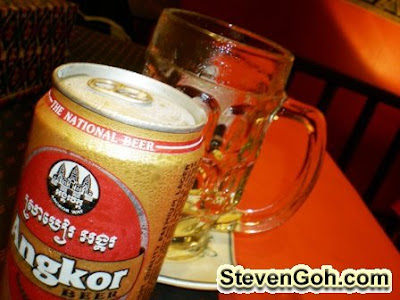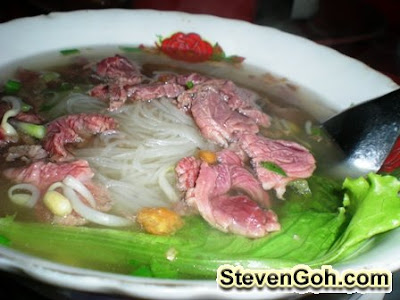Before I visited Cambodia, I have done some research on their food, accommodation and also the culture. Mostly of the information that I found in terms of culture and food are very similar from one to another. However the accommodation and spending vary. Some really spent thousands of USD while some only spent hundreds USD over the same trip and places of visits. For me I have only spent few hundreds USD. This is acceptable for most budget travelers.
After my previous post on tips and things to do in Cambodia, this round is about the great food in Cambodia.
Firstly is the welcome drink from The Golden Temple Villa. This drink is FREE for the guests who stay in the hotel on their first day of arrival. It is just an ordinary lime juice but the nice part is that the container used really looks traditional Khmer style.
After my previous post on tips and things to do in Cambodia, this round is about the great food in Cambodia.
Firstly is the welcome drink from The Golden Temple Villa. This drink is FREE for the guests who stay in the hotel on their first day of arrival. It is just an ordinary lime juice but the nice part is that the container used really looks traditional Khmer style.
 Khmer’s banana, tasted a bit sour and biting tongue. It not as nice as our local bananas. Maybe because it belongs to the lower grade. Anyhow it’s free.
Khmer’s banana, tasted a bit sour and biting tongue. It not as nice as our local bananas. Maybe because it belongs to the lower grade. Anyhow it’s free. Khmer Coffee, there is some signature aroma that tells you it is Khmer Coffee, like what you get the signature smell from Coffee Bean or Starbucks. This Khmer coffee is something that will keep you awake while you still feel sleepy. By the way the coffee is FREE during our entire stay at the guest house.
Khmer Coffee, there is some signature aroma that tells you it is Khmer Coffee, like what you get the signature smell from Coffee Bean or Starbucks. This Khmer coffee is something that will keep you awake while you still feel sleepy. By the way the coffee is FREE during our entire stay at the guest house. We usually had American Breakfast at Golden Temple Villa for breakfast. Such as Omelettes and Scrambled Eggs with bread, nothing too special about it. However the great part is the price per set starts from only USD 1.75.
We usually had American Breakfast at Golden Temple Villa for breakfast. Such as Omelettes and Scrambled Eggs with bread, nothing too special about it. However the great part is the price per set starts from only USD 1.75. For alcohol lovers, this place is a heaven. No matter what type of beers in Siem Reap is cheap. Be it Angkor Beer or Anchor beer, Thai beer or Chang beer, they are all at the same price range from USD 0.70 to USD 0.75 per can.
For alcohol lovers, this place is a heaven. No matter what type of beers in Siem Reap is cheap. Be it Angkor Beer or Anchor beer, Thai beer or Chang beer, they are all at the same price range from USD 0.70 to USD 0.75 per can. If you are looking for great food while traveling, there is a nice food court located opposite Neak Pean Wat. You can stop by for some nice food to fill your stomach. The stall that I had my meal was Stall No 5.
If you are looking for great food while traveling, there is a nice food court located opposite Neak Pean Wat. You can stop by for some nice food to fill your stomach. The stall that I had my meal was Stall No 5. One fresh coconut with juicy coconut water is sufficient for 2 people, with each cost USD1. I am a bit regret of ordering one for myself instead of sharing. I have wasted nearly 1/2 of the coconut water.
One fresh coconut with juicy coconut water is sufficient for 2 people, with each cost USD1. I am a bit regret of ordering one for myself instead of sharing. I have wasted nearly 1/2 of the coconut water. Dishes that I have ordered for lunch. It will be best for each of you to order a dish and share among each other. For 4 people who travel in a group you might consider 3 dishes which will be more than enough for 4 people. As for the rice is FOC even for refill. Average of each dish is around USD 3.
Dishes that I have ordered for lunch. It will be best for each of you to order a dish and share among each other. For 4 people who travel in a group you might consider 3 dishes which will be more than enough for 4 people. As for the rice is FOC even for refill. Average of each dish is around USD 3.Pineapple fried pork/ Beef/ Chicken, is a Thai dish but very famous in Cambodia. I ordered pork which I find a bit stinky. Maybe the way they cook is different. If you don’t like the smell of pork, chicken or beef will be better alternatives for you.
 Amok, is a must try in Cambodia. If you haven’t tasted this food you are considered as never been to Cambodia. Amok is actually the name of the great chef who cooked for Khmer’s King last time. This dish is one of the signatory of the chef and the taste is so great that Khmer used his name for this dish. This dish is cooked with coconut cream, spicy paste, long beans, onion, Green leaves and egg whites and they come with choices of Chicken, Pork or Beef. However I was told by our tour guide that Amok is best served with fish meat.
Amok, is a must try in Cambodia. If you haven’t tasted this food you are considered as never been to Cambodia. Amok is actually the name of the great chef who cooked for Khmer’s King last time. This dish is one of the signatory of the chef and the taste is so great that Khmer used his name for this dish. This dish is cooked with coconut cream, spicy paste, long beans, onion, Green leaves and egg whites and they come with choices of Chicken, Pork or Beef. However I was told by our tour guide that Amok is best served with fish meat. Chicken/ Pork/ Beef fried with lemon grass. Very nice dish with strong aroma of lemongrass. I have a very strong feeling that this dish originated from Thailand as I remember I did triy that dish before when I was in Phuket.
Chicken/ Pork/ Beef fried with lemon grass. Very nice dish with strong aroma of lemongrass. I have a very strong feeling that this dish originated from Thailand as I remember I did triy that dish before when I was in Phuket. If you would like to go for more decent restaurants in Siem Reap, Khmer Kitchen Restaurant could be the one. It is located along the pub street /old market place of Siem Reap. This is a very famous place where any Tuk tuk driver will be able to bring you there. Again each of the dish here costs USD 3 per and the rice is FOC.
If you would like to go for more decent restaurants in Siem Reap, Khmer Kitchen Restaurant could be the one. It is located along the pub street /old market place of Siem Reap. This is a very famous place where any Tuk tuk driver will be able to bring you there. Again each of the dish here costs USD 3 per and the rice is FOC. One of the great food that I tasted here is the Khmer Style Soup. It is cooked with lemon grass, lime leaves, garlic, ginger, chili, Galangal, lemon, herbs with the choice of Fish/ Chicken/ Pork/ Beef/ Tafu/ Mix Vege.
One of the great food that I tasted here is the Khmer Style Soup. It is cooked with lemon grass, lime leaves, garlic, ginger, chili, Galangal, lemon, herbs with the choice of Fish/ Chicken/ Pork/ Beef/ Tafu/ Mix Vege. Khmer Curry, is cooked with coconut cream, spicy paste, chili, potato, yam, pumpkin and carrot and again with the option of Fish/ Chicken/ Pork/ Beef/ Tafu/ Mix Vege.
Khmer Curry, is cooked with coconut cream, spicy paste, chili, potato, yam, pumpkin and carrot and again with the option of Fish/ Chicken/ Pork/ Beef/ Tafu/ Mix Vege. If you wanted to try out something different than hotel or restaurant food, there is a good place for you to hang out which is the street beside the old market place. If you know how to get to the only convenience stall here in old market place, it is just located opposite the shop.
If you wanted to try out something different than hotel or restaurant food, there is a good place for you to hang out which is the street beside the old market place. If you know how to get to the only convenience stall here in old market place, it is just located opposite the shop. This lady is very aggressive in inviting customers and promoting her stall. JWithin 10 minutes, she has managed to pull in 10 customers. I wonder how much she earns per night. Anyway the food here are cheap compared to the one we had in hotels or restaurants. Average cost per plate is USD 1.
This lady is very aggressive in inviting customers and promoting her stall. JWithin 10 minutes, she has managed to pull in 10 customers. I wonder how much she earns per night. Anyway the food here are cheap compared to the one we had in hotels or restaurants. Average cost per plate is USD 1. Traditional Vietnamese Rice Noodle Soup with Beef (Pho). The soup base is sweet and cooked with beef, rice noodle, bean curd and vagetable. It is simple and nice.
Traditional Vietnamese Rice Noodle Soup with Beef (Pho). The soup base is sweet and cooked with beef, rice noodle, bean curd and vagetable. It is simple and nice. Fried noodle (MA MA) with chicken, the typical fried “maggi” mee that we used to order at Indian mamak stalls. The noodle is thinner compared to our maggi mee here. The thickness and the size is very similar to Thai style instant noodle.
Fried noodle (MA MA) with chicken, the typical fried “maggi” mee that we used to order at Indian mamak stalls. The noodle is thinner compared to our maggi mee here. The thickness and the size is very similar to Thai style instant noodle. Overall, these food are very nice and presentable. If there are any Khmer food served in Penang, I feel that the business will be very good just like Miss Saigon’s Restaurant in Penang. Anyway, on my next post will be the street snack and the food that I will never try for the second time.
Overall, these food are very nice and presentable. If there are any Khmer food served in Penang, I feel that the business will be very good just like Miss Saigon’s Restaurant in Penang. Anyway, on my next post will be the street snack and the food that I will never try for the second time. Stay tuned!











